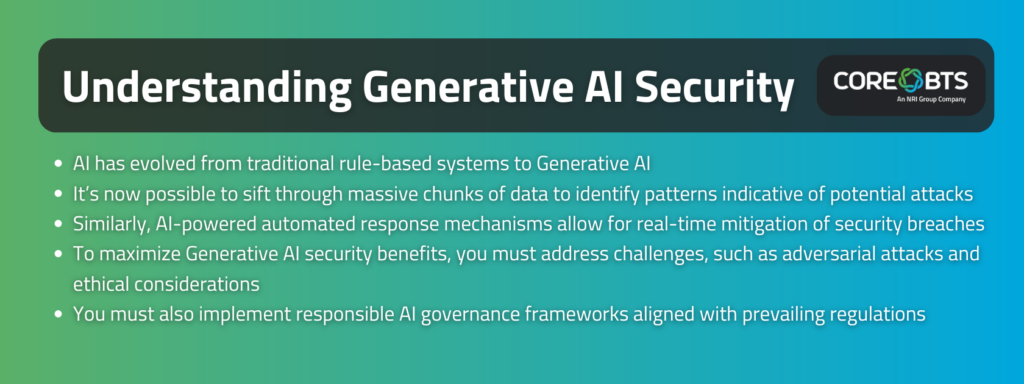Discover how AI is changing the way companies manage their security posture.

Is your company’s security strategy keeping pace with the artificial intelligence (AI) revolution? If not, you might be setting yourself up for avoidable problems. With threats rapidly evolving, there’s never been a more critical time to be proactive about security.
This article explores how AI is transforming security practices and why it’s crucial for your company to adapt. You’ll learn how AI enhances threat detection, automates incidence responses, and helps you avoid emerging risks. Let’s dive in.
The Evolution of AI in Security
Security management has considerably improved with AI over the last few decades. We’ve gradually moved from rule-based systems to more capable Generative AI ones.
In traditional rule-based systems, we would apply a series of predefined “if-then” statements to address known security issues.
For example, in an intrusion detection system, we might set a rule: “If an unauthorized user attempts to access the network more than three times within 5 minutes, then trigger an alert and temporarily lock the user account for 30 minutes.”
Such a rule enhances security by preventing brute-force attacks while notifying security staff of the threat in parallel.
However, the more we used rule-based systems, the more their limitations came to light. For example:
- As security complexity increases, the number of rules needed grows exponentially, hindering scalability
- Reliance on predefined rules limits the flexibility of rule-based systems to adapt to new threats without a “human in the loop” constantly modeling new rules
Machine learning (ML) provides a better approach to handling modern threats’ dynamic and complex nature. Unlike traditional rule-based systems, ML algorithms can learn, improve, and adapt to complex scenarios.
Deep Learning, a domain of ML, uses Generative Pre-Trained Transformers (GPTs) for more efficient data analysis and autonomous decision-making.
Once trained, these Generative AI models can:
- Learn and understand even the most complex data structures and patterns
- Create new content by mimicking what they’ve learned
That means you have a powerful tool to level up your security posture. With Generative AI, you can monitor threats, manage vulnerabilities, and optimize other security workflows like never before.
Watch our on-demand Generative AI Strategies webinar to learn the 6 “Ws” of successful AI integration.
Generative AI and Threat Detection
A recent IBM report states that threat intelligence allows up to 28 days faster threat detection. So, you’re right to consider incorporating Generative AI into your overall cybersecurity strategy.
Generative AI integration allows you to continuously monitor your network traffic, system events, and log data to identify anomalies and get instant alerts when a security breach is about to occur.
It also keeps you one step ahead by efficiently processing historical security and threat intelligence data points for insights into how bad actors could compromise your organization now and in the future.
Generative AI capabilities help you understand attack vectors and prepare for threats that don’t exist. The shift from a reactionary to a proactive security posture means your team can finally maximize the benefits of existing security tools.
Generative AI and Incidence Response
Understandably, businesses prefer thwarting threats before or as soon as they occur. But this doesn’t always happen. According to IBM, the gap between businesses identifying, analyzing, and responding to a threat is about 64 days—that’s more than two months for adversaries to exploit your systems.
Generative AI bridges the gap by automating incident response processes, including recovery, remediation, and containment.
It allows you to quickly:
- Triage and prioritize incidents based on potential impact, severity, and relevance
- Terminate and block malicious processes and traffic
- Disable compromised user accounts
- Quarantine affected network segments, devices, and files
- Initiate countermeasures to neutralize threats
Additionally, you can constantly evolve your automated response mechanisms as the underlying AI model learns from past incidents.
Challenges and Risks
Generative AI isn’t a silver bullet, though. Like any powerful tool, it has challenges and risks, one of the biggest being adversarial attacks.
As you can imagine, cybercriminals keep up with AI developments and look for loopholes as organizations automate security. One strategy they often use is targeting the logic governing incident response capabilities to make the system dormant or execute an unwanted action.
For example, they could deliberately trigger the security system to isolate multiple endpoints simultaneously, leading to a denial of service (DoS) attack. Or they may execute some other disguised attack. It’s crucial to consider such possibilities when managing security with Generative AI.
There’s also the issue of ethics. As AI systems act autonomously, how do we ensure they uphold privacy rights and remain fair and unbiased? Every company deploying AI for security must be intentional with these questions.
Regulatory Compliance
As AI reshapes security management, it’s also impacting the regulatory environment. Data privacy laws like GDPR and CCPA are among those. In the coming years, we’re likely to see more rules addressing AI use in security.
What does this mean for you?
You’ll need to ensure your AI systems are transparent, explainable, and compliant with relevant data protection laws. A good start is creating a robust AI governance framework that establishes accountability guidelines and clearly defines where human adjudication is needed for the right balance.
A reliable partner can help with this and other aspects of your transformation.
The Future of AI in Security
What’s next for AI in security? For one, better capabilities. We’ve barely scratched the surface of what’s possible. Future security systems will predict and prevent attacks with more panache. At the same time, the next generation of cyber threats will be more sophisticated as attackers leverage smarter AIs. The key to staying ahead is continuous innovation and adaptation. That means evolving your defense at a faster rate than threats.
Transform Your Security Strategy with Generative AI
Generative AI dramatically enhances threat detection and incident response capabilities, which is why leading organizations rapidly embrace it. You, too, can unlock the AI superpower and join these front runners. But remember, with great power comes great responsibility. It’s crucial to consider AI’s challenges and risks and establish a proactive governance strategy for success.
If you haven’t yet, watch our on-demand webinar to learn the fundamentals of Generative AI and how to implement outstanding solutions.
At Core BTS, we believe that technical debt and outdated infrastructure shouldn’t be a limitation. We are committed to helping the most impactful businesses rebuild their digital core capabilities—including AI— to stay competitive today and tomorrow. Our pros can get your data and applications ready for AI so you can elevate your security posture sooner.
Contact us now to learn more.






Share on